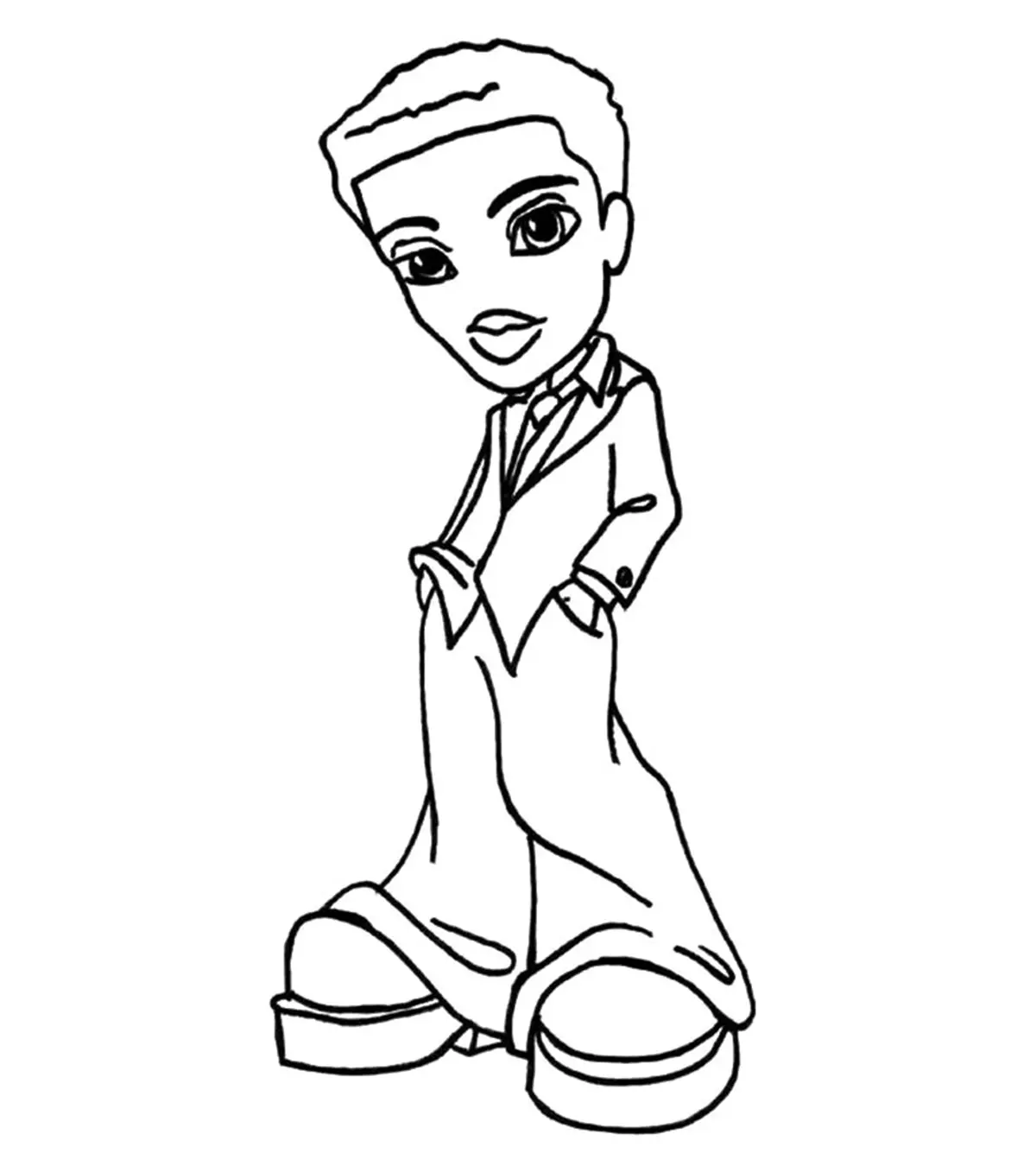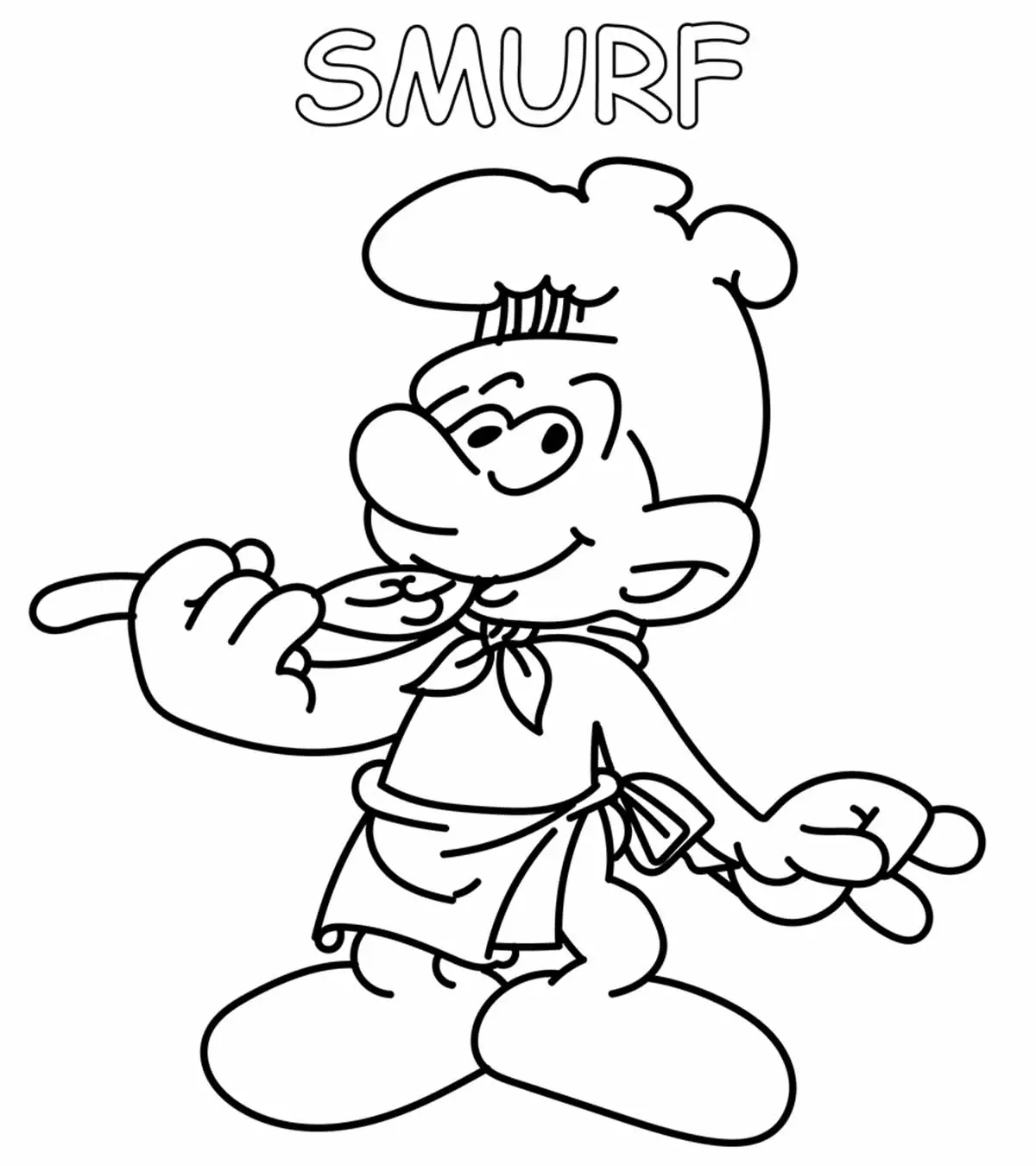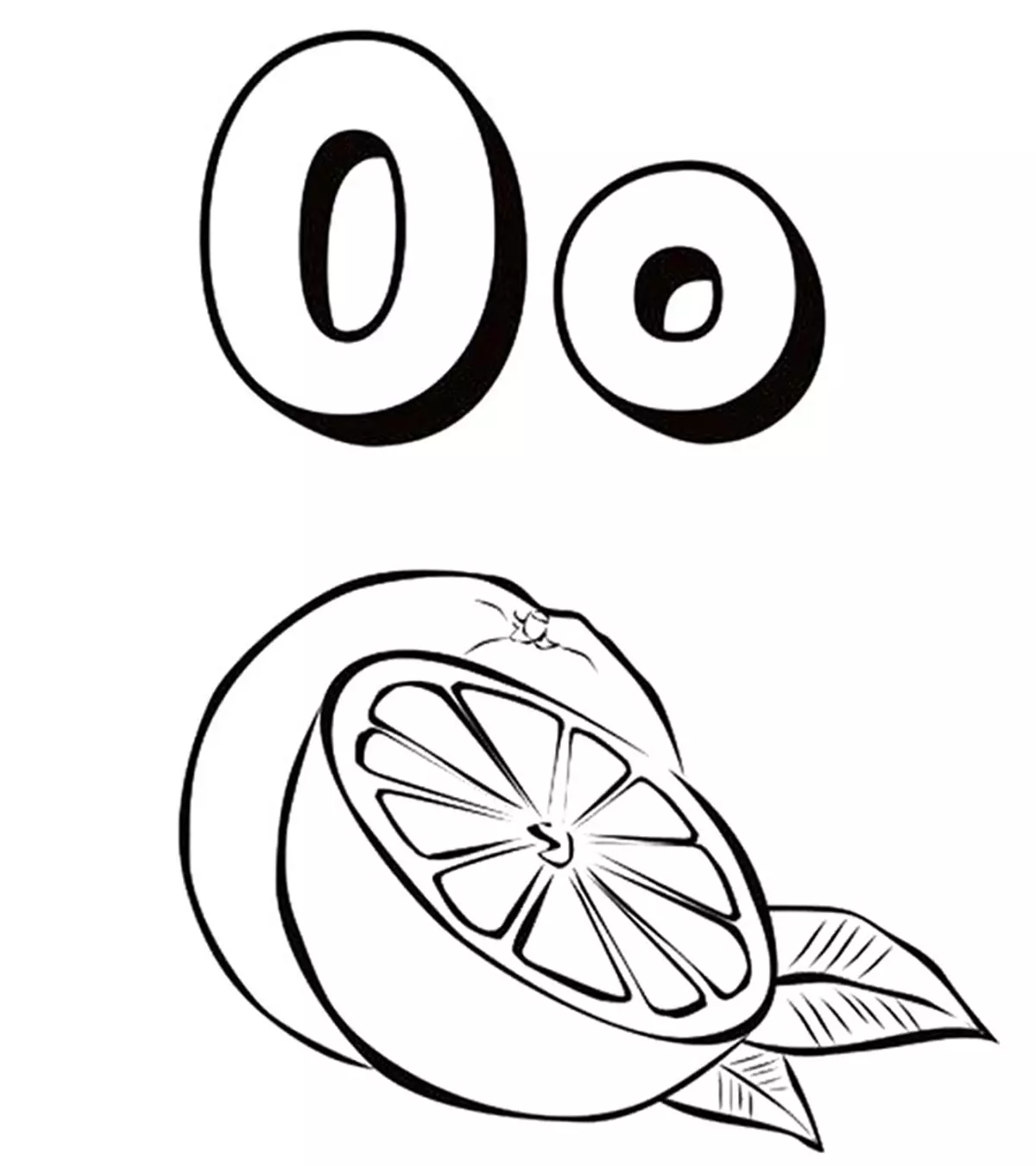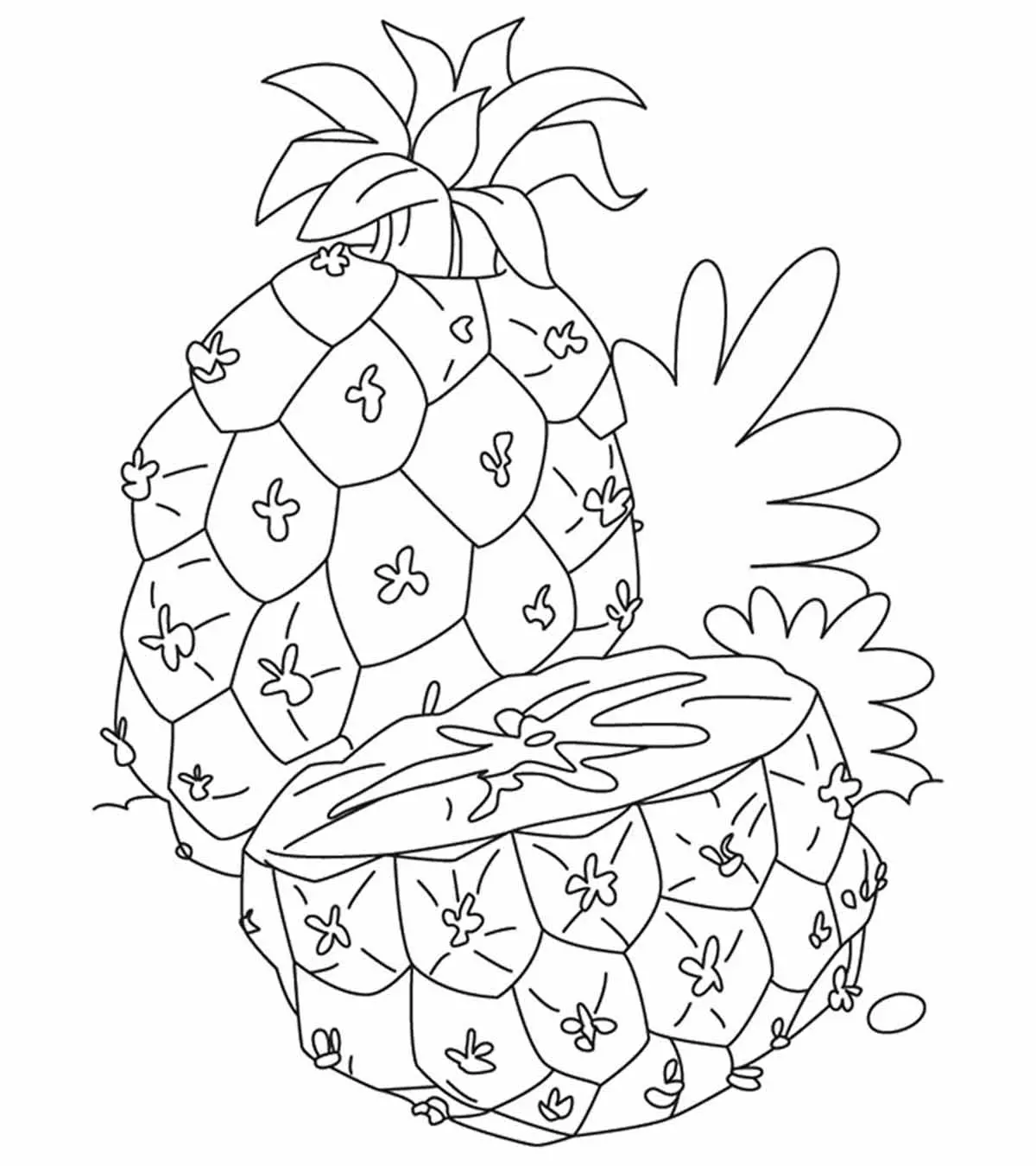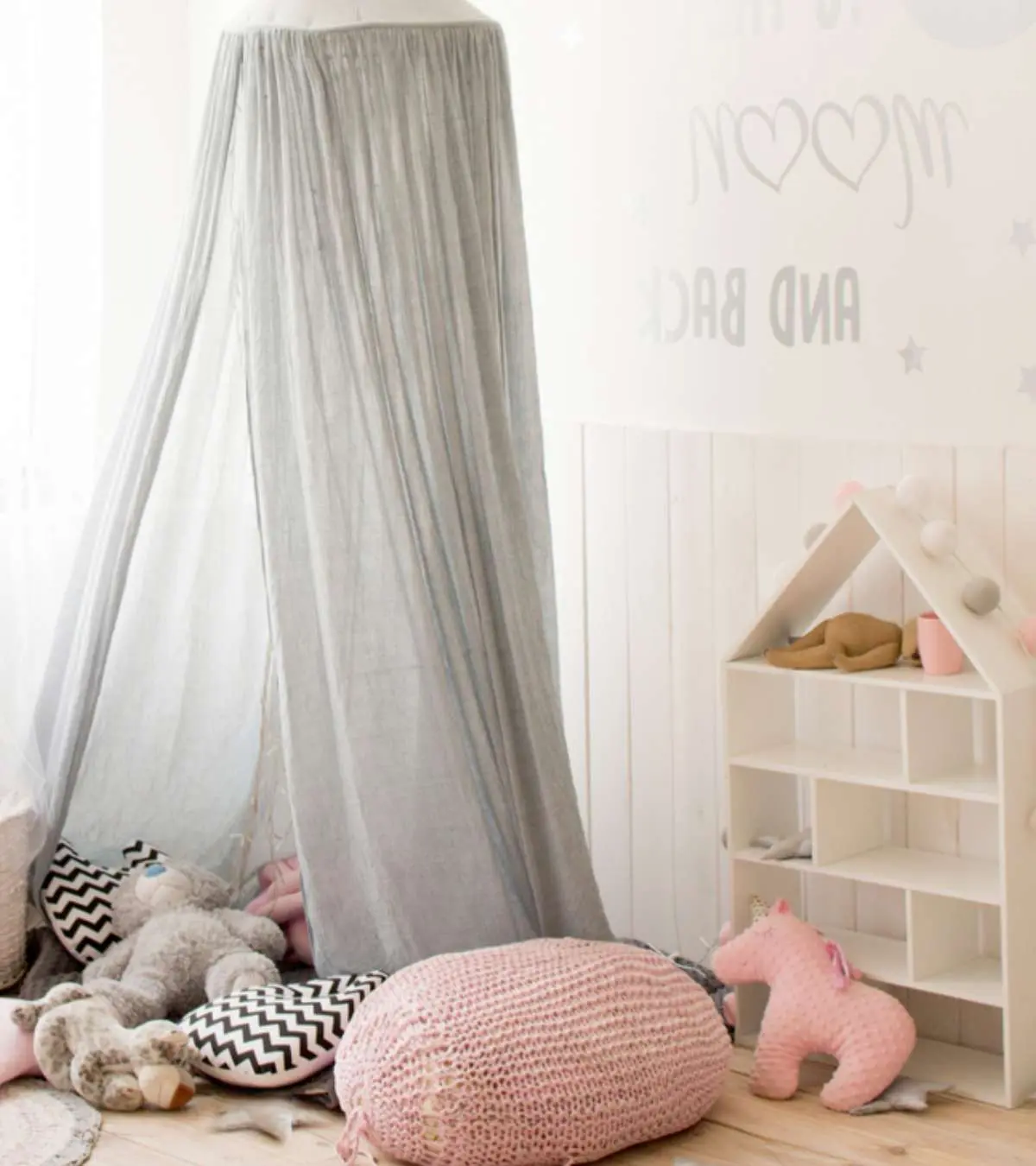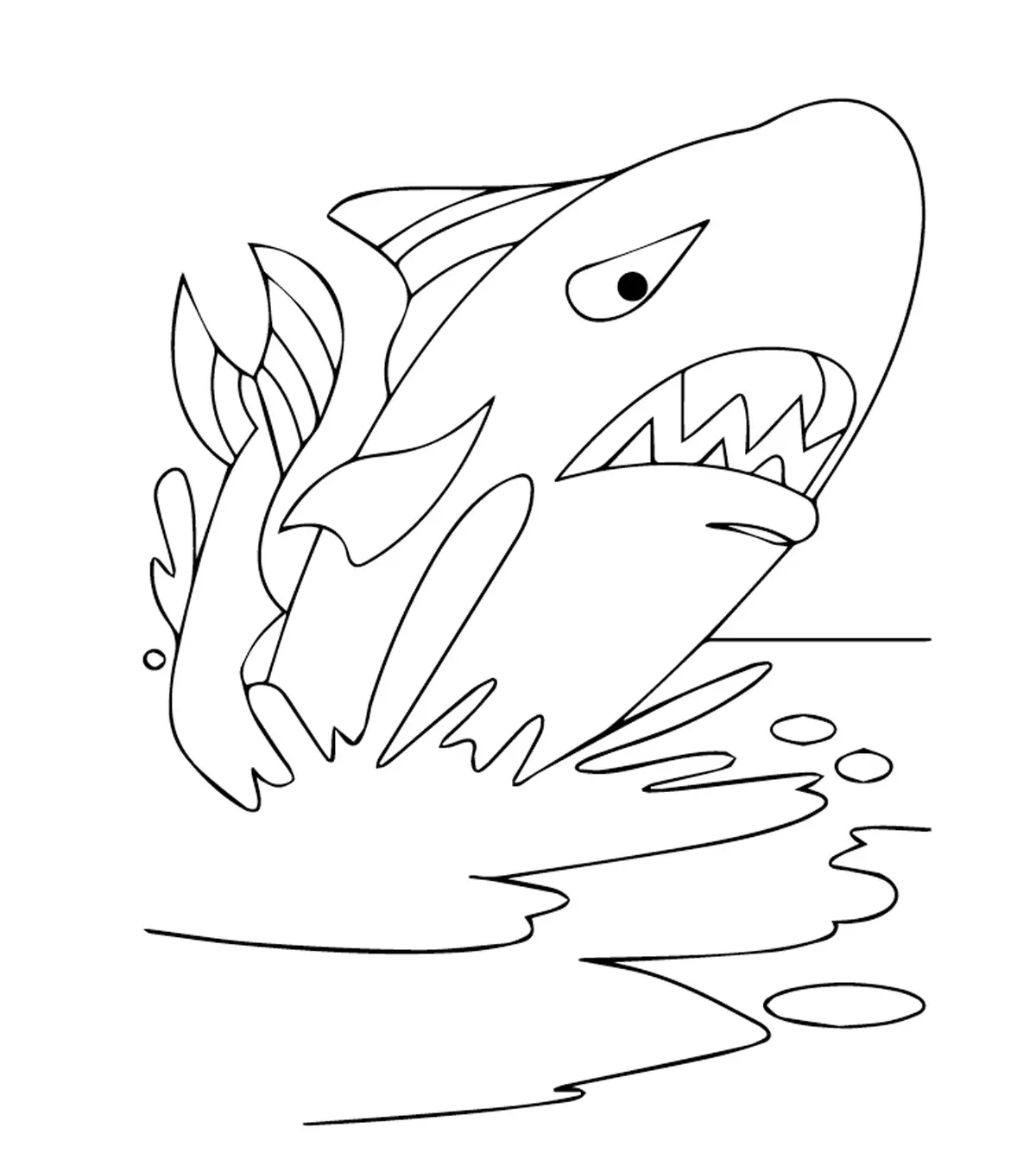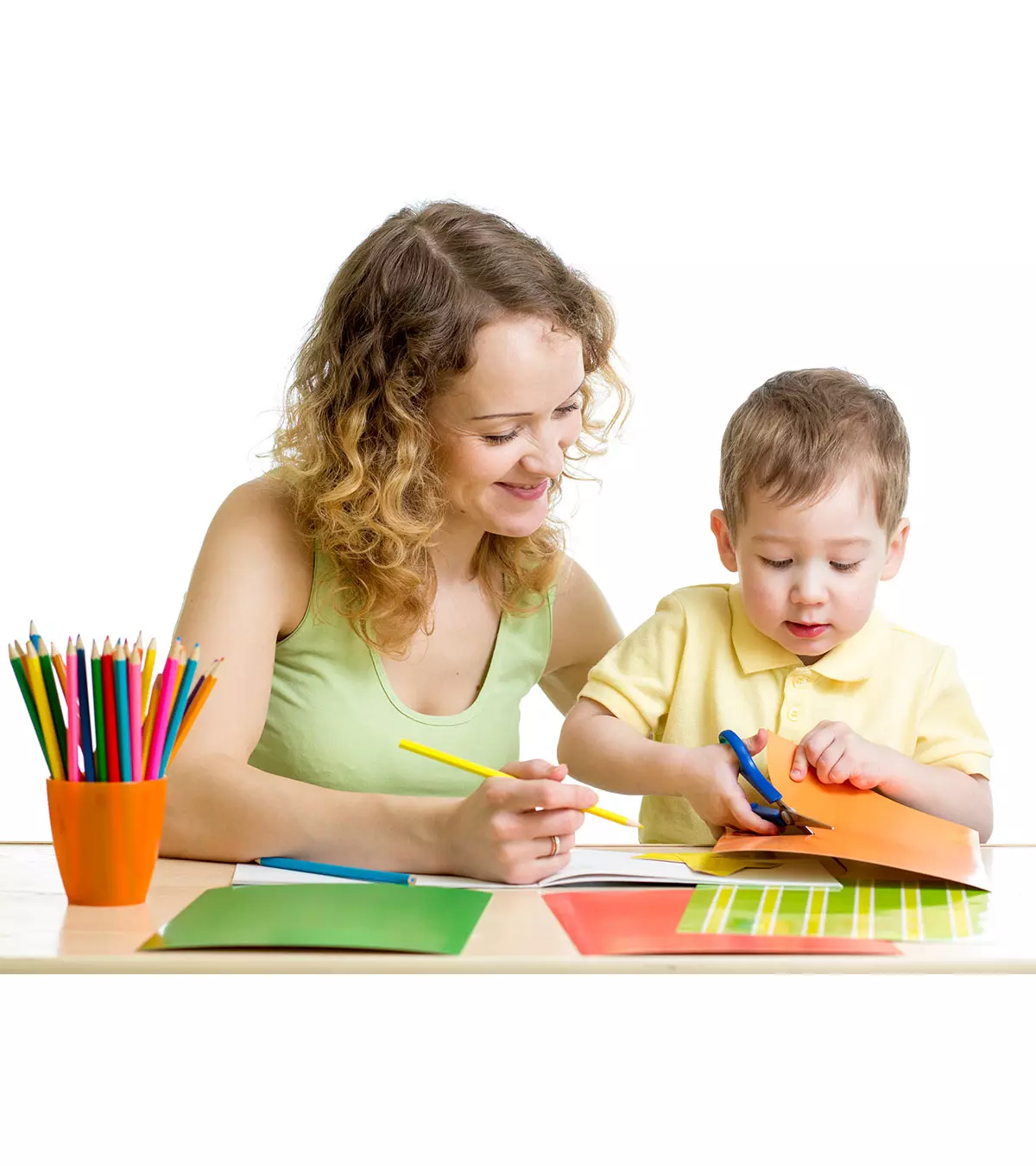
Learning about shapes is important for children to understand the world around them. At schools, kids learn about shapes: their sides, vertices, names, etc. However, such learning can also start at home with shape-learning games for kids. By introducing these concepts at an early age you can help them develop a strong foundation for learning mathematics and geometry in the future.
When children encounter challenges that involve identifying shapes and forms of objects, it contributes to critical thinking and improving
improving motoriAm ability to move and control various body parts, especially hands, legs, and fingers. and sensory skillsiThe ability to obtain, process, and infer information through the major senses, namely, smell, sight, touch, taste, and hearing. . It also contributes towards better cognitive development, spatial awareness, and hand-eye coordination. So, explore the games listed below to find a suitable one for your children. Read on to know more.
Key Pointers
- To comprehend the world around them, children should learn about shapes.
- Developing hand-eye coordination, motor, and sensory skills can be achieved by playing shape-learning activities at home.
- Online shape games for kids include I Love Shapes, Shape Construction, Purpy’s Shapes, and Shape Lab.
- Two examples of 2D shape learning activities are “Matching the Shapes” and “Trace and Color the Shapes.”
- “Math Under the Sea” is an online game that can help children learn about 2D and 3D forms.
Online Shape Games For Kids
Most kids love computer games. So why not use them to teach your children a bit about shapes?
1. I Love Shapes
Your child can play this game on the PBS website. With Curious George, the monkey from the animated TV series with the same name, your child gets to learn all about basic geometric shapes.
This easy, interactive, multimedia game requires the child to remember the shape displayed at the beginning and help George collect that shape to score points. The game has multiple levels, with each level tougher than the previous one.
Try this game online here.
2. Shape Construction
A colorful game to teach children about geometry and symmetry, Shape Construction is similar to match the shapes. It is available on ABCYA.com, an interactive ABC Network website for kids. The objective of the game is to use your imagination and place the correct shape in the right place to complete the construction of the building.
The game has multiple levels that get progressively more difficult.
Play Shapes Construction online here.
 Point to consider
Point to consider3. Purpy’s Shapes
Purpy’s Shapes is a digital interactive matching game in which the child has to make the connection between the geometric shape and everyday objects. The game is realistic and will keep your child busy thinking about the shapes of things they see, even after it ends, encouraging curiosity and innovation. Teach your kids to play this game, and in no time they will start noticing the shape of different objects.
Try Purpy’s Shapes, online game, here.
4. Shape Lab
Shape Lab is a kids learning shapes game by BBC Bitesize Maths. The game is suitable for older children and requires considerable knowledge about classification of geometric shapes, and the number of sides they have. Each time scientist Pablo gives you a hint, and you need to find the right image to help him complete the experiment. The game is attractive with colorful visuals and background sounds.
Try BBC Shape Lab game for kids here.
5. Math Under The Sea
Math Under The Sea is an initiative by LearnAlberta.ca to teach children about the concept of 2D and 3D shapes, and also the terminology associated with it. This game is ideal for older kids who are familiar with concepts like sides, edges, faces, and vertices. The game is easy to play and can be used as an excellent tool to practice these concepts.
Play Math Under The Sea shapes game here.
2D Shape Learning Activities
2D shapes are basic shapes such as a square, rectangle, circle, and triangle among others. Some activities also include shapes of vegetables, fruits, and other everyday objects. These activities help children remember and identify shapes.
6. Matching the Shapes

You can try this activity by using a color paper or cloth. It needs a little bit of preparation though.
You will need:
- 2 drawing or craft sheets
- Scissors
- Pencil or sketch to draw shapes
- Glue
What to do:
- Cut different shapes out of the chart paper. These could be shapes of vegetables, fruits, vehicles, geometric shapes for kids to learn and other objects they see every day.
- Draw the same shapes or patterns on the other chart paper.
- Give the shapes to the child and ask him to place the right shape at the right place.
This activity is a great way to reinforce what the child has learned at school.What kids learn:
Identifying and memorizing shapes
This activity is a great way to reinforce what the child has learned at school.
What kids learn: Identifying and memorizing shapes
This activity is ideal for first graders or kids who have just been introduced to the concepts of geometry. To reduce the preparation time, you can also buy ready-to-use wooden cutouts of different shapes for the activity.
7. Trace and color the shapes
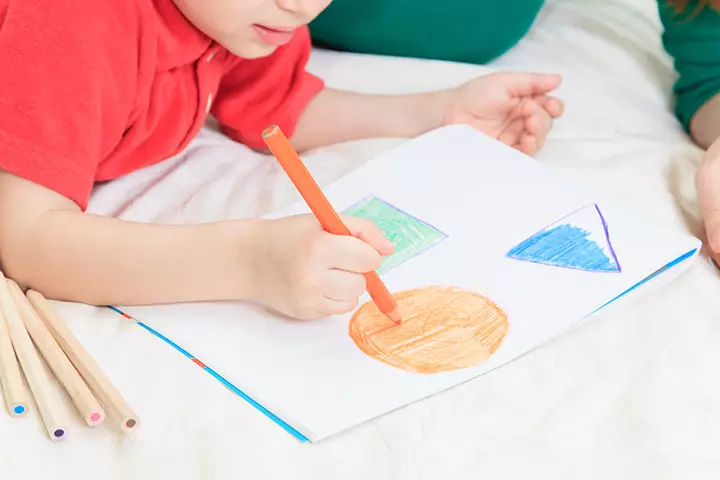
This is a pretty simple activity to help the child memorize shapes.
You will need:
- A coloring book with geometric shapes or a blank drawing book
- Pencil and eraser
- Color pencils or crayons
What to do:
- Draw the geometric shapes in the coloring book. The shapes should be big enough to trace and color.
- Show the child how to trace the shape.
- Let the child trace the shape first and then color it.
What kids learn: Making and identifying shapes
8. Cut the shape

This activity focuses on teaching children about shapes and also enables them to improve hand-eye coordination.
You will need:
- Craft paper
- Sketch pens
- Scissors for the child
What to do:
- Draw the shapes on the craft paper. Choose easy-to-cut shapes depending on the age of the child. You could choose anything from basic shapes to paper dolls, animals and more.
- Start by demonstrating how to cut a shape along the outline.
- Let the child cut out the shapes and also name them.
Make sure you are with the children when they are using the scissors for the activity.
9. Bake A Shape

Who wants some cookies? If your child does, he will have to name that shape first!
You will need:
- Cookie dough mix
- Cookie cutters
What to do:
- Prepare the cookie dough as per the instructions on the box.
- Flatten the dough for the cookies.
- Use differently shaped cookie cutters – stars, hearts, circles, triangles, flowers and so on – to cut the cookies from the flattened dough and bake them.
- Every time you give the child a cookie, make sure they name the shape.
- You could ask them relevant questions about the shape if they want more than one.
What kids learn: Identify shapes, make solid shapes using molds
 Did you know?
Did you know?3D Shape Learning Games
Shape recognition and understanding help the child interact with the environment and process visual information (1). Cubes, cuboids, and spheres are three-dimensional shape games for kids with more than one face.
10. Shape Sorting

Is there a difference between a cube and a cuboid? Is an oval the same as a sphere? Some shapes may be similar and confusing for the kids. Here is an activity that enables your kids to differentiate between two shapes.
You will need:
- Toy blocks
- Shape sorter (optional)
What to do:
- Put all the blocks in a basket or a bag.
- Let your child pick the blocks one-by-one, and categorize them based on their shape.
- Every time the child does that, ask him to name that shape.
What kids learn:
Memorizing shapes, identify and describe attributes of shapes
11. Wooden Shapes Puzzle

A puzzle helps in building spatial intelligence and understanding of how shapes fit together. Wooden shape puzzles are ideal for children in primary school.
You will need:
- 1 Puzzle set
What to do:
The objective is to get your child to complete the puzzle while naming each shape. The more the child plays, the better she will understand the shapes and remember their characteristics.
What kids learn: Memorizing shapes, logic
12. Play With Clay

Clay molds or play-doh boosts creativity and can also be used to make 3D shapes.
You will need:
- Play-doh or similar clay modeling kit
- Plastic molds to make shapes
What to do:
Use the plastic or metal frames to make 3D patterns like a cube, sphere, stars, tree and more. You can also make these shapes by molding the clay without using the blocks.
Mrs. Myers, a teacher, shares how she crafted a 3D shape challenge to engage students in learning about shapes. She explains, “There has been a big interest in three dimensional shapes. They (her students) need to be able to name them and describe the attributes of the shapes. I set up the invitation below for them to create both 2D and 3D shapes using marshmallows and toothpicks. They loved this! They also had to try their best to draw and label their shape. They glued a label onto their shape that had their name and the shape name (i).”
What kids learn: Making 3D shapes, getting creative
13. Shape flashcards
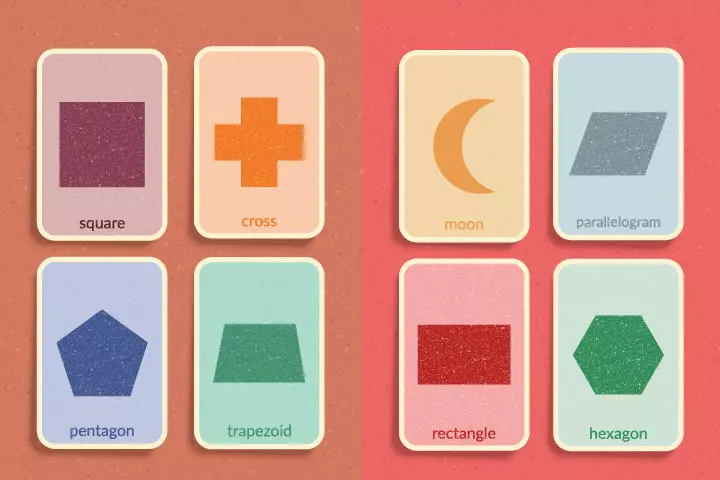
Flashcards can be an excellent way to test your child’s knowledge and prepare them for a test or exam. Shape flashcards can also be effective for reinforcing a younger child’s learning by providing feedback. Motivation and assessment will help the child understand his shapes.
You will need:
A set of flashcards for geometric shapes – pick the appropriate pack with the child’s knowledge of shapes or geometry.
What to do:
- You can use flashcards with just the shape and ask what it is called or use cards with the name of the shape and ask the child to draw the shape.
- With older kids, you can use these cards to talk about the features such as the number of sides and edges of a geometric shape, if it is a 3D shape or a 2D shape, what type of polygon it is and so on.
What kids learn:
Memorizing what they learned about shapes or geometry.
14. Shapes We See
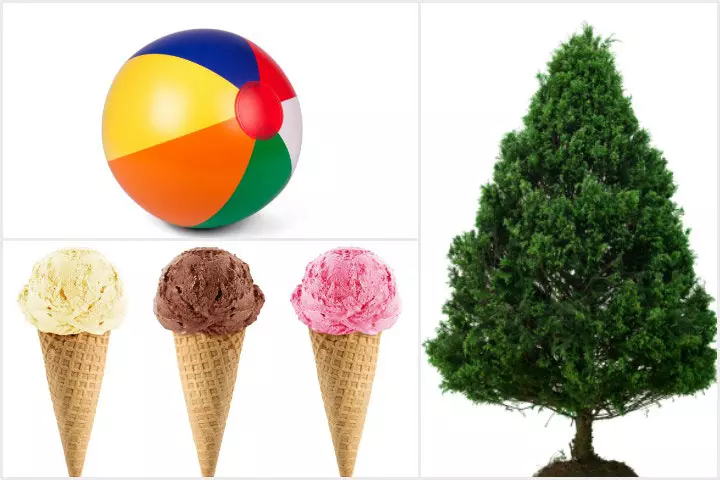
This is an activity that you and your child can indulge in every day.
You will need:
Time, presence of mind
What to do:
Whenever you look at a new object or vegetable or fruit, ask the child what shape it is. Asking random questions will make this activity more like play and less like a lesson. You can repeat the question about a shape to reinforce what was learned.
Understanding shapes is an essential part of early education that helps create a foundation for children to develop their problem-solving skillsiThe ability to identify problems, analyze the needs, and solve them tactfully. , math, geometric concepts, and visual discrimination and analysis. Although these concepts are taught in school, you may introduce them in the form of shape-learning games for kids at home and support their holistic development. Teaching shapes through games and activities will enhance children’s learning, understanding, and memorizing skills from a young age. So, explore games, such as shape construction, matching shapes, and baking a shape suitable for your child’s age. Indulge in the activities with your children and make learning fun for them.
Frequently Asked Questions
1. How can I guide my child during shape-learning games and activities?
Choose activities that match their age and cognitive abilities and create a conducive environment free from distractions. Be actively involved in the process and offer encouragement and support whenever required. And if the game or activity is online, set screen time limits to help prevent fatigue.
2. How do these games help in improving visual perception in children?
These shape activities for toddlers could exercise skills related to visual processing, attention to detail, and spatial awareness. The child scans and identifies patterns, shapes, and colors when playing these games, enhancing their visual discrimination and recognition abilities.
3. How do shape-learning games help children recognize patterns and identify similarities?
Shape-learning games provide children with opportunities to explore and manipulate various shapes. Regular exposure to these shapes and patterns makes it easier for the child to remember and recollect them, improving their ability to recognize shapes and patterns.
4. How can shape-learning games be used to improve spatial reasoning skills in children?
These educational activities for kids involve manipulating shapes and spatial relationships. Through these, children can develop their ability to visualize objects in their minds and understand how they relate to each other in space.
Infographic: Fun Games To Make Children Learn About Shapes
Learning about shapes is a fundamental concept for children because everything they see around them reflects the same. The infographic below brings you fun ways to teach them different things. Since all these games involve playing and learning, your little ones can have a wonderful time.

Illustration: Momjunction Design Team
Illustration: Best Shape-Learning Games And Activities For Kids

Image: Stable Diffusion/MomJunction Design Team
Let’s play the Name the Shape Game with Jack Hartmann! Learn to identify shapes and have fun with this exciting shape review game!
Personal Experience: Source
MomJunction articles include first-hand experiences to provide you with better insights through real-life narratives. Here are the sources of personal accounts referenced in this article.
i. Using 21st century skills to create our own math games, a 3d shape challenge, and more;https://mrsmyerskindergarten.blogspot.com/2016/02/using-21st-century-skills-to-create-our.html
References
- Everyday Edges and Shapes.
https://www.pathstoliteracy.org/everyday-edges-and-shapes/ - Exploring Shapes.
https://www.mensaforkids.org/teach/lesson-plans/exploring-shapes/
Community Experiences
Join the conversation and become a part of our nurturing community! Share your stories, experiences, and insights to connect with fellow parents.
Read full bio of Ashley KZ Showell
Read full bio of Harshita Makvana
Read full bio of Deepa Thomas
Read full bio of Trisha Chakraborty










